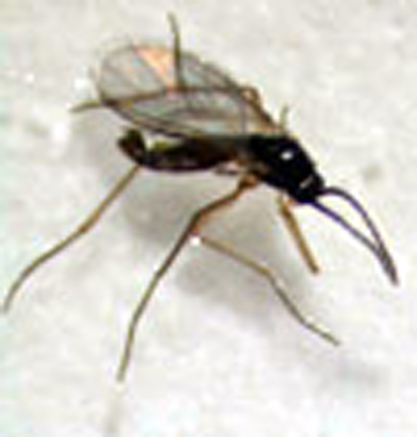
Fungus Gnats are not the worst pest you can encounter, but they are one of the most common. At first you will notice small 1/8” dingy gray flies fluttering around the plants and you might also notice them coming out of the soil. The Fungus Gnat adults that you see flying around are not feeding on your plants. They lay their eggs in the soil and their larvae feed on decaying organic matter and the tips of roots. This is what causes damage to your plants.
The Fungus Gnat life cycle takes about 4 weeks from egg to adult. In heated greenhouses and indoor grow rooms they reproduce all year long. They are not usually a problem outdoors, and do not survive cold winters. Eggs are very small, laid in the soil or in dead and decaying organic matter. Fungus Gnat larvae do not have legs and look like small white worms with black heads. They are approximately 1/4” long and are semitransparent. They pupate in the soil and emerge as a winged adult. Adults live 7-10 days and females lay up to 300 eggs. Eggs take about 6 days to hatch into larvae, which then feed for approximately 12 days. The pupal stage takes about 5 days to complete.
As larvae feed on the fine root hairs and root tips, the plants may appear to wilt, grow slowly, or start to turn yellow. Vitamin B1, Mycorrhizae fungus, and other root enhancing products should be applied to help the roots grow back healthy. Predatory Insects or safe insecticides should be used to control the Fungus Gnats. Sticky traps can be used to catch some of the adults and monitor their numbers. Slices of potato, placed on top of the soil, seem to draw the larvae to the surface where they can be counted to monitor the infestation and removed. Some growers have had good results with a 1/2” layer of sand placed on top of the soil. As with anyt other pest, prevention is important. Always inspect new plants before introducing them to your greenhouse.
Predator Nematodes attack the Fungus Gnat larvae in the soil. A few repeat applications spaced 3-6 weeks apart is usually enough to take care most infestations. Fungus Gnat Predators (Hypoaspis miles) can also be used. They attack the Fungus Gnat larvae and other small pests in the soil. Sprinkle Fungus Gnat Predators throughout the growing area onto soil surfaces, capillary mats, hydroponic media, and planting beds. Be sure to treat all wet, exposed areas of soil and greenhouse floors. If Fungus Gnat populations are low, 5,000 Hypoaspis can treat up to 200 square feet. All Fungus Gnat Predator life stages occur in the top 1/2” of soil. They do well in most environments, but do not like constant flooding from hydroponic systems.
Small populations of Fungus Gnats do not cause a lot of damage. However, small populations turn into big infestations that cause a lot of root damage. Be sure to attack Fungus Gnats as soon as you notice them fluttering around the greenhouse. It will make life better for you and your plants.
Nathan Jackson is the owner of Nature’s Control and Ladybug Indoor Gardens. You can send your specific bug questions to nathan@naturescontrol.com. For more information, to request a catalog, or to find a local distributor, check out Naturescontrol.com or call (541) 245-6033.
Related Articles
Dealing with Fertilizer Powders
Growing Healthy, Productive and Profitable Plants through Succession Planting




Comment here